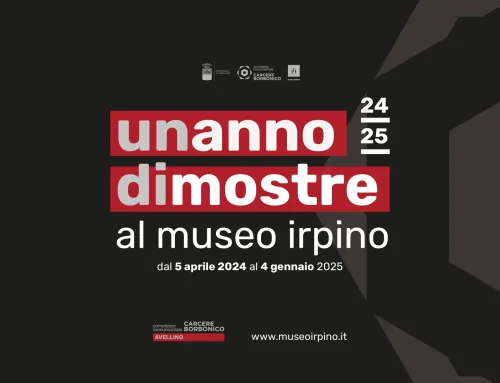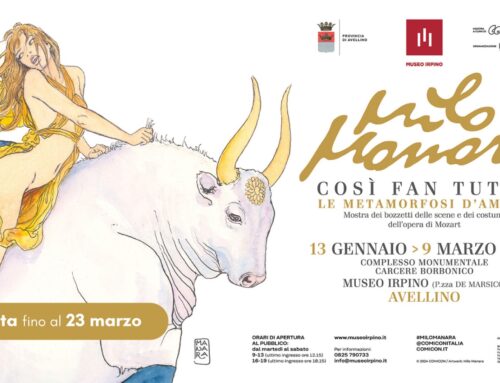Show Kaleidoscope Freiburg
edited by Andrea B. Del Guercio
Monumental Complex Bourbon Prison
Press preview Saturday 8 October 2022 at 11.00
Exhibition opening Saturday 2 October 8 2022 at 5.00 pm
On Saturday 8 October, at 5.00 pm, at the Monumental Complex Prison Bourbon of Avellino, on the occasion of the eighteenth Day of Contemporary Art organized by AMACI, the exhibition Kaleidoscope will be inaugurated, a collective of 22 artists of different nationalities united in a single exhibition project: Susanne Allgaier, Petra Blocksdorf, Celia Brown, Alexandra Centmeier, Jan Douma, Carola Faller-Barris, David Gnandt, Anja Kniebühler, Angelina Kuzmanovic, Alfonso Lipardi, Irina Lozinskaja, Julius MartinHumpert, Birgit Olzhausen, Jürgen Oschwald, Chris Quutovic, Almutovic Quaas, Rebecca Speth, Gabriela Stellino, Konrad Wallmeier, Jennifer Weigt, Ulrike Weiss.
The exhibition, curated by Andrea B. Del Guercio, was born from the collaboration of the Irpino Museum and the MONTOROCONTEMPORANEA association.
Writes Andrea B. Del Guercio curator of the exhibition:
‘ A succession of doors leading to a series of medium-sized ateliers, inside a two-storey building which was perhaps intended to house offices connected to the railway station, represents one of the constant stages of my residences in Freiburg over the course of five or six years. I find it very interesting that the city has maintained its support for artists through the tradition of the Artist’s Studies, born as early as the end of the 19th century and distributed throughout most of Europe; a cultural reality that in Freiburg is divided into a large number of sites interacting with the entire urban fabric; the widespread presence of art, understood in the operational dimension of ‘doing’ and not just that of exhibiting – from museums to galleries – allows the same population to discover and grasp the value of individual cultural and aesthetic skills; the value of this reality is clearly connected and confirms the ‘kaleidoscopic’ dimension of our own project “Kaleidoskop Freiburg”. The Artist’s Studio and the Opera. I had the opportunity to visit and attend the studios of a large number of artists and to grasp all the importance that this experience provides so as to place the ‘recording’ of what I have seen and heard at the center of this second volume as well. , discussed and filtered through my culture and my sensitivity, with the aim of involving the reader-visitor, allowing him to go back to the places where the works were conceived and created. Exactly as was the case for the previous publication, we intend to document the work of the invited artists captured within the operational spaces, the result of a critical confrontation that took place directly – thus avoiding the too widespread mediation of communication and the web – with each individual author, conducted through a dialogue that allowed a phase of study. The photographic documentation of the works in the studios becomes the significant and characterizing data of a project that intends to suggest to the ‘reader’ a visit to the place and an encounter with the work. In fact, I asked each artist to act documentarily on this relationship, that is, on the operational dimension of making art. It will be possible to observe the different environmental solutions, the tools and from these to the processes that led to the realization before proposing the works for exhibition use. The text therefore attempts to ‘tell’ at least a part of a large system of creative residences, both public and obviously also private, to which are added different, in terms of structure and concept, home / studio, but also galleries that become temporary places of art production; significant in this regard is also the process of recovery and use of former industrial buildings, alongside the frequentation of that elegant historic residence, surrounded by greenery towards the area of the old station. All operational realities for art that allow an aggregation and sharing of interests and professional exchanges; environments now silent and collected, now spectacular and enveloping.Alongside these somewhat hidden private spaces, such as Alfonso Lipardi’s studio set in a context of different activities and daily life, Susanne Allgaier’s home-studio, perfectly inserted into the wood to the point of being part of it, the impeccable order and the brightness that is ‘overturned’ in the works of Petra Blocksdorf, the spaces recovered and transformed with respect to the first destinations and today destined for culture and art in which Carola FallerBarris works, large and ancient houses and micro studios perfectly responding to expressive needs, but also those private places where the family dimension is perfectly combined with the artistic one, where all the data of everyday life intersect and add up in response to the art-life dialectic, offer the reader-visitor an ideal entry into the distribution of the daily functions of city of Freiburg. A process that cannot fail to recall the ancient workshops and laboratories of art, but also historic houses of writers and musicians and studios of great Masters, who are now registered and become part of the history of art itself, qualifying the cultural dimension stratified of a city and a territory. We know perfectly well that the very places of making art today can in fact be completely similar, now to the workshop dimension of an artisan, now to the ‘think tank’ of a philosopher in which canvases and papers, tools and plaster, replace but relate to books and sheet music, to become libraries of visual language: those who cannot ‘live’ with their imagination the experience of memory knowing that here was Tintoretto’s house in Venice just beyond the bridge of the Jewish ghetto, or there towards the Giudecca Canal the Studio of Emilio Vedova in what were the Magazzini del Sale, or in the Latin Quarter of Paris the simple House-Studio of Eugène Delacroix (just to name a few illustrious names, alongside a rich example of ‘minor’ realities but fundamental to tell a Kaleidoscopic History of Art). I find it very interesting to be able to document all this, with respect for personal confidentiality, with the desire to reveal to the ‘reader’ the fundamental role of the ‘place’ in which the works are born, the result of the artist’s stable and operational permanence. ‘
The exhibition promoted by the Province of Avellino, is organized by the Irpino Museum in collaboration with MONTOROCONTEMPORANEA, organizational direction of Gerardo Fiore.
Patronages: Province of Avellino, City of Montoro, Honorary Consul of the Federal Republic of Germany in Naples, City of Friborg (D), Irpino Museum, Cultural Association T66, Friborg; ‘At the same time’ cultural association. Partner: ART4ART
At the opening night there will be:
-Rizieri BUONOPANE, President of the Province of Avellino
-Giovanna SILVESTRI, Technical Scientific Coordinator of the Museum and Library
-Girolamo GIAQUINTO, Mayor of the City of Montoro
-Andrea B. DEL GUERCIO, curator
-Gerardo FIORE, Director of MONTOROCONTEMPORANEA
The exhibition will be open until November 30 during the Museum’s opening hours (Tuesday to Saturday, 9-13, 16-19).
The event is part of the Contemporary Day and is promoted by AMACI – Association of Italian Contemporary Art Museums and created with the support of the Directorate General for Creativity Contemporary of the Ministry of Culture, and the collaboration of the Directorate General for Public and Cultural Diplomacy of the Ministry of Foreign Affairs and International Cooperation.
For info
avellinosbn@gmail.com
info@museoirpino.it
0825 790526 (Library)
0825 790539 – 790733 (Museum)








